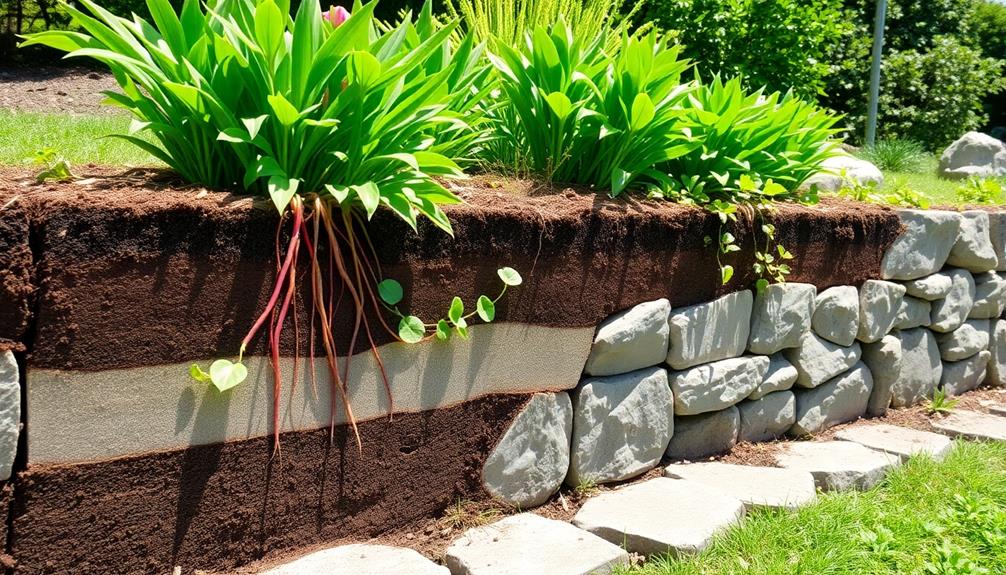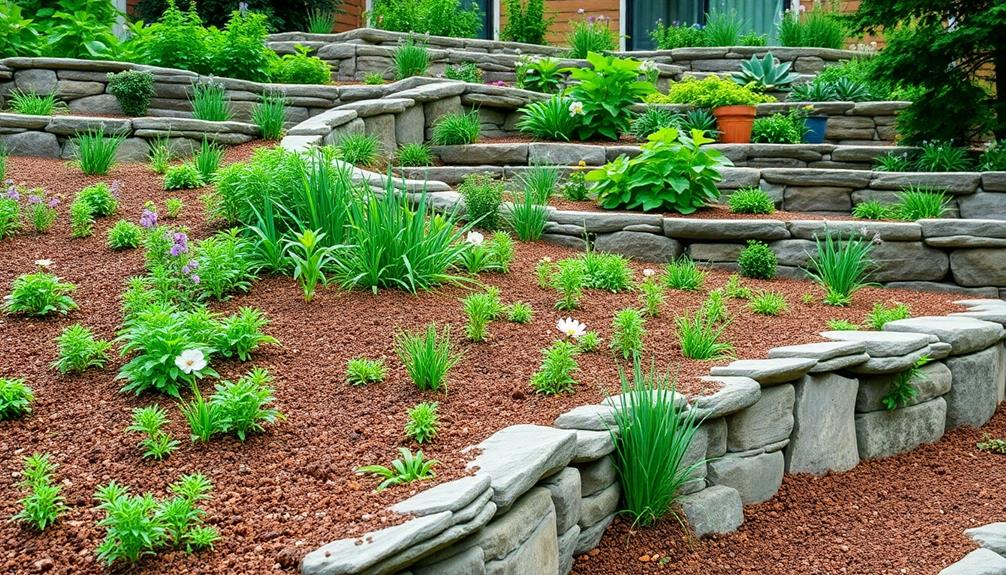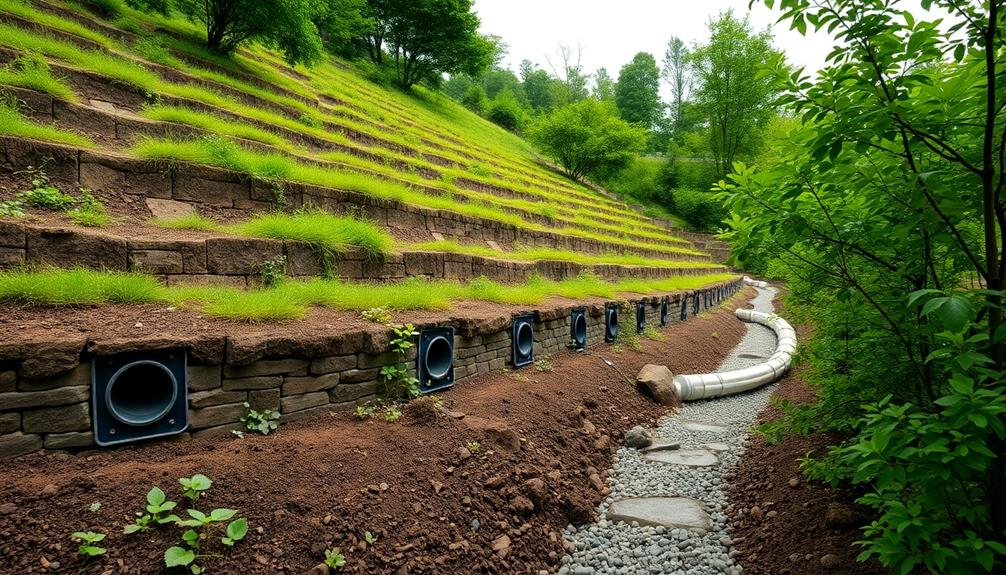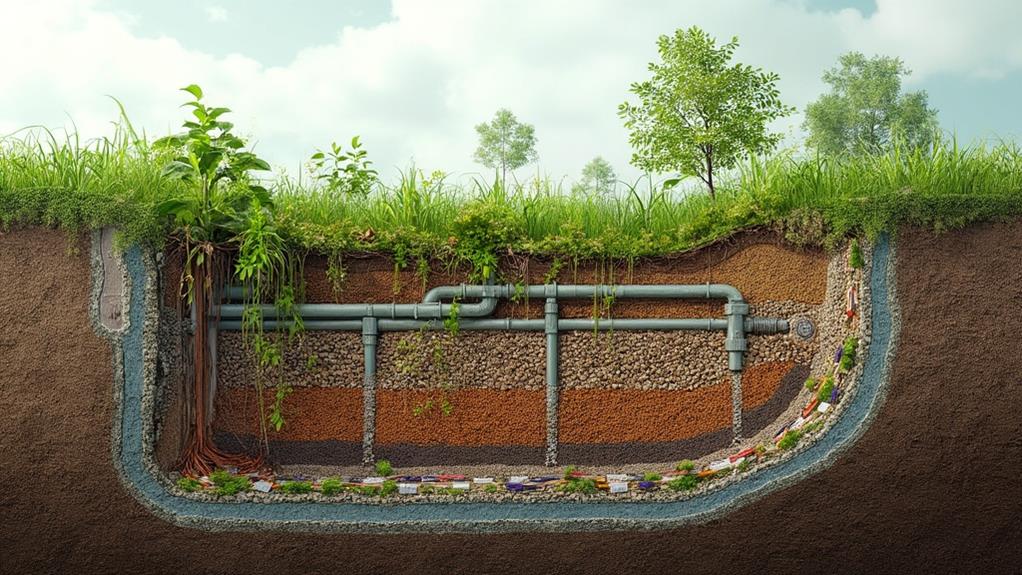When planning soil for retaining walls, it is imperative to evaluate soil stability and drainage requirements carefully. Consider the load-bearing capacity, shear strength, and soil type, avoiding clay due to its water retention and expansion properties. Granular soils like sand and gravel offer excellent drainage and should be compacted to bolster support and reduce void spaces. Effective drainage systems, such as gravel backfills and perforated pipes, manage hydrostatic pressure and prevent structural faults. Additionally, the use of geotextiles and strategic vegetation can control erosion and integrate the retaining wall seamlessly with its environment. Continue exploring to uncover the full scope of essential considerations.
Table of Contents
ToggleWalls Contractor Highlights
- Evaluate soil load-bearing capacity and shear strength to ensure structural integrity and stability.
- Use granular soils like gravel for optimal drainage and soil compaction.
- Implement an effective drainage system to manage water flow and prevent hydrostatic pressure build-up.
- Avoid expansive clay soils, opting for compatible natural and backfill soil types instead.
- Include erosion control measures, such as geotextiles and strategic vegetation, for increased stability.
Purpose of Retaining Wall Soil

The soil selected for retaining wall applications plays a pivotal role in ensuring the stability and effectiveness of the structure, addressing both drainage needs and the compaction requirements specific to the soil type. For instance, understanding how soil types affect erosion control is part of our expertise when evaluating site conditions and providing design recommendations.
Proper soil selection and management are indispensable not only for adequate support against lateral soil pressure but also for effective soil erosion control, which can compromise the long-term durability of the retaining wall. Understanding the interplay between these factors is essential for constructing a viable solution that resists environmental stresses and maintains structural integrity over time.
Stability and Drainage Needs
When building a retaining wall, understanding the soil's stability and drainage needs is essential to ensuring long-term effectiveness and safety. Stability is the cornerstone of a successful retaining structure. It prevents potential hazards, offering assurance that the wall will maintain its integrity under pressure. To achieve this, evaluating the soil's load-bearing capacity and shear strength is fundamental. Detailed soil analysis can anticipate how well it will perform, especially when exposed to significant stress over time.
Equally imperative is addressing drainage needs, as improper management can compromise stability. Water accumulation behind a retaining wall can lead to increased hydrostatic pressure, threatening the wall's structural soundness. Consequently, implementing effective drainage systems, such as gravel backfills, weep holes, or perforated pipes, aids in water control, preventing undue stress.
Compaction and Soil Type
Getting the soil composition and compaction levels just right is essential for the efficiency of a retaining wall. These factors play a pivotal role in the wall's ability to withstand lateral soil pressure and guarantee long-term stability. The soil's load-bearing capacity is a direct result of its careful composition and compaction, requiring attention to detail during the planning phase of construction. A well-prepared foundation can prevent structural faults by allowing the wall to function harmoniously with the soil.
Consider the following critical aspects:
- Soil Type Selection: Using granular soils such as gravel and sand is advantageous due to their excellent drainage properties. Conversely, clay should be avoided as it retains water and expands.
- Adequate Compaction: Enhanced soil compaction decreases void spaces, which bolsters shear strength and reduces settlement, supporting the wall's integrity.
- Soil Compatibility: Compatibility between natural and backfill soils minimizes unwanted interactions, promoting unity in construction materials and natural surroundings.
- Load Implications: Understanding the soil's load requirements guarantees that the selected soil and compaction method provide ideal support for the wall's expected capacity.
Through meticulous planning and consideration of these components, a well-constructed retaining wall serves as a durable and enduring structure, contributing positively to the landscape's safety and aesthetics.
Soil Erosion Control
Imagine watching a well-kept garden slowly deteriorate due to soil erosion—this is one of the key issues a retaining wall is designed to mitigate. Soil erosion, a natural process intensified by water flow and gravity, can destabilize landscapes, disrupt gardening projects, and lead to significant structural concerns. Entrusting the integrity of a beloved outdoor space to a retaining wall involves understanding its function as an indispensable barrier against these erosive forces.
Properly engineered, retaining walls serve to preserve the aesthetic and structural intentions of a landscape, maintaining its beauty and utility for both personal enjoyment and the shared pride within a community.
To achieve effective soil erosion control, the composition and arrangement of soil behind a retaining wall must be meticulously planned. This involves selecting specific soil types that provide structural support and adequate drainage, reducing the hydraulic pressure exerted on the wall. Geotextiles or compacted backfills might be necessary to augment soil stability and water drainage.
Additionally, incorporating strategic vegetation can minimize erosion by anchoring soil layers with root systems. By understanding and implementing these elements, one can safeguard that retaining walls not only uphold their architectural purpose but also sustain the ecological health and continuity of cherished landscapes.
Benefits

The strategic selection and use of appropriate soil for retaining walls offer numerous advantages that enhance both functional and aesthetic aspects. Enhanced structural stability is a key benefit, as it reduces the risk of wall failure and supports the longevity of the structure.
Additionally, it aids in efficient erosion control and drainage, while contributing to the overall visual appeal of landscaping projects through seamless integration with the natural environment. Such integration guarantees that the retaining wall does not only serve its functional purpose of battling gravity and keeping soil in place but also becomes a decorative extension of the home, boosting curbside charm and allowing for creative and architectural soundness in wall designs.
Enhanced Structural Stability
Proper soil selection is crucial in ensuring that retaining walls perform their intended functions effectively, as specific soil types directly impact the wall's ability to withstand pressure and maintain its form. By carefully choosing the appropriate soil, stakeholders can forge collective trust in the wall's resilience. Ensuring that different parties are aligned in understanding the importance of soil choices fosters a sense of community and shared responsibility.
How does the choice of soil contribute to the enhanced structural stability of retaining walls? Proper soil selection is crucial in ensuring that retaining walls perform their intended functions effectively, as specific soil types directly impact the wall's ability to withstand pressure and maintain its form. By carefully choosing the appropriate soil, stakeholders can forge collective trust in the wall's resilience. Ensuring that different parties are aligned in understanding the importance of soil choices fosters a sense of community and shared responsibility.
- Compaction Characteristics: Well-compacted soil increases the wall's resistance to lateral pressure, enhancing its load-bearing capacity. Soils with superior compaction qualities solidify the wall's backbone against structural shifts.
- Drainage Capacity: Selecting a soil type with optimal drainage properties, such as sandy or gravelly soils, reduces the buildup of hydrostatic pressure, thereby protecting the wall from moisture-related deterioration.
- Cohesion Levels: Cohesive soils, often rich in clay content, offer inherent stability. However, a balanced incorporation of cohesive and granular soils can provide increased strength and stability.
- Grain Distribution: A well-graded soil mixture, integrating various particle sizes, forms a denser unit, providing necessary structural support and distributing pressure evenly.
These considerations collectively bolster the retaining wall's structural integrity, blending both function and form seamlessly.
Erosion Control Advantages
In addition to enhancing structural stability, the selection of appropriate soil plays a crucial role in mitigating erosion around retaining walls. By carefully choosing soil with properties that resist displacement, the longevity and integrity of the wall structure are considerably improved. Soil composition, particularly one that consists of coarse particles like sand and gravel, can effectively anchor the base of a retaining wall, providing a reliable buffer against the forces of erosion. This critical feature minimizes the gradual wearing away of the earth, preserving both the functionality and aesthetic appeal of the retaining wall.
Furthermore, opting for soil that possesses inherent binding properties can greatly enhance the wall's overall erosion resistance. When integrated with stabilizing vegetation, such soil promotes the growth of roots that intertwine with the earth, forming a natural mesh that holds it firmly in place. This synergistic relationship between soil and vegetation not only fortifies the retaining wall but also fosters an environment where community engagement with nature is cultivated. The unity of sound soil selection and strategic planting creates sustainable spaces that resonate with a community's values, ensuring both safety and beauty for years to come, while indirectly fostering a sense of shared stewardship.
Improved Drainage Systems
Regularly overlooked yet critically important, improved drainage systems offer substantial benefits to retaining walls. Implementing such systems not only strengthens the structural integrity of retaining walls but also enhances the longevity of the construction.
Effective drainage mitigates hydrostatic pressure build-up behind the wall, which if unmanaged, can lead to wall failure. The community of homeowners and developers alike can agree that a well-planned drainage system is an investment in safeguarding any retaining wall project.
Consider the following benefits drawn from improved drainage practices:
- Preventing Water Damage: By efficiently directing water away, drainage systems secure the wall from erosion and weakening, extending its lifespan considerably.
- Enhancing Soil Stability: Ensuring the soil behind the wall remains compact and dry minimizes the risk of soil shifts, creating a safer environment.
- Reducing Maintenance Costs: Long-term maintenance requirements diminish as the wall remains robust, decreasing the need for frequent repairs.
- Environmentally Responsible Management: Proper drainage systems contribute to better water management, reducing runoff and promoting sustainable landscapes.
Integrating these strategies into your retaining wall planning not only aligns with community priorities of environmental stewardship but also fosters a sense of pride in maintaining safe and sustainable structures.
Aesthetic Landscaping Benefits
While the structural benefits of retaining walls are undeniable, their aesthetic potential is equally significant in creating visually appealing landscapes. These walls serve not only to fortify and stabilize sloped terrains but also to introduce a harmonious blend of natural and constructed beauty into outdoor spaces. By carefully selecting the materials and design, homeowners can enhance the visual allure of their surroundings, transforming functional elements into artful expressions of their personal taste and environmental appreciation.
The aesthetic impact of retaining walls extends beyond their immediate vicinity, weaving seamlessly with the broader landscape. Utilizing a variety of materials such as natural stone, brick, or textured concrete, each wall can be designed to reflect an individualized stylistic vision. This variety enables a customization that appeals to diverse tastes while ensuring cohesion with the existing landscape. In addition, these walls can support vibrant planters and cascading flora, creating visually mesmerizing contrasts and layers that draw the eye and invite admiration.
Strategically placed lighting and water features can accentuate the elegance of retaining walls, increasing their allure and prominence at any time of the day. Consequently, the aesthetic possibilities afforded by retaining walls are as integral to their function as their foundational strength.
Drainage System Considerations

Effective drainage systems are critical in retaining wall design, guaranteeing adequate water flow management and preventing the detrimental effects of water accumulation. The selection of proper materials plays a pivotal role in facilitating these drainage functions, thereby enhancing the durability and performance of the structure. The following table outlines key considerations related to drainage system components and their functions:
| Consideration | Description |
|---|---|
| Water Flow Management | Ensures consistent and efficient water movement |
| Water Accumulation Prevention | Mitigates pressure and erosion risks |
| Material Selection | Influences drainage efficiency and longevity |
| Structural Integrity | Maintains wall stability and functionality |
Adequate Water Flow Management
Proper drainage systems are essential in guaranteeing the stability and durability of retaining walls. Adequate water flow management extends beyond merely redirecting water; it requires a comprehensive understanding of the surrounding environment to prevent pressure build-up that could compromise structural integrity.
Soil Permeability: Determine the permeability of the soil behind the wall, as highly permeable soils allow water to flow through easily, reducing hydrostatic pressure. This is indispensable in selecting the appropriate drainage solutions tailored to your specific needs.
Grading and Slope Design: Expertly designed slopes away from the wall ensure surface water is efficiently directed towards designated drainage areas, preventing undesirable water pooling at the base, which can undermine the wall's foundation over time.
Use of Drainage Pipes: Incorporate perforated pipes, often referred to as "French drains," placed at the base of the wall to facilitate water movement away from the structure, guaranteeing a balanced water distribution system in the vicinity of the wall.
Retaining Wall Filters: A geotextile filter placed behind the wall can effectively separate soil from drainage aggregates, maintaining free-flowing conditions and preventing soil clogging in the drainage channel.
Prevent Water Accumulation
Moisture management remains a critical consideration in the design of retaining walls to prevent water accumulation and the associated risks of structural failure. Effective drainage systems are essential in mitigating hydrostatic pressure buildup behind retaining structures, as waterlogged conditions can jeopardize the integrity of both soil and structure. Installing weep holes is a practical strategy, enabling trapped water to exit and alleviating internal pressure.
Meanwhile, a perforated drainage pipe positioned at the base of the wall, enveloped in gravel and a geotextile fabric, aids in directing water away from the structure, maintaining soil stability and reducing the likelihood of erosion.
Proper grading around the retaining wall should facilitate natural water runoff, minimizing pooling adjacent to the wall. The angle of slope should encourage precipitation to flow away from the wall surface, preserving structural equilibrium. Concurrently, impermeable barriers, such as membranes or cohesive soils, can be applied to the wall's rear face to restrict water infiltration.
Through these measures, not only is the potential for saturation and freeze-thaw cycles diminished, but a cohesive bond among the constructed elements and surrounding environment is sustained, ensuring long-term durability and harmony in the landscape design.
Proper Material Selection
Selecting appropriate materials for the drainage system in retaining wall construction is essential for ensuring long-term functionality and stability. Drainage systems are integral in managing hydrostatic pressure and preventing water accumulation behind the wall, which could otherwise compromise structural integrity. The process of selecting materials involves understanding the interplay between soil type, drainage requirements, and environmental factors unique to each site.
To guide you in making informed decisions, here are four crucial components to ponder:
- Geotextile Fabric: This permeable fabric is pivotal for separating soil layers and preventing sediment from clogging drainage pipes while allowing water passage. Its inclusion helps maintain soil stability and prolongs the efficiency of the system.
- Gravel Backfill: Utilizing graded gravel around drainage pipes facilitates effective water movement while minimizing soil erosion, which is indispensable for maintaining the foundational strength of the retaining wall.
- Drainage Pipes: Typically constructed from PVC or corrugated plastic, these pipes serve as conduits for water to escape, reducing hydraulic pressure on the retaining wall and ensuring its durability.
- Weep Holes: Strategically placed openings in the wall facilitate the controlled release of excess water, preventing the build-up of pressure that could lead to wall failure.
Each of these components plays a seminal role in creating a reliable and efficient drainage system, ensuring your retaining wall remains robust over time.
Walls Contractor FAQ
How Does Climate Affect the Choice of Soil for Retaining Walls?
Climate greatly impacts soil selection for retaining walls, as variations in temperature, precipitation, and drainage patterns influence soil stability, erosion potential, and moisture retention. Choosing the appropriate soil guarantees durability and structural integrity for enduring communities.
What Type of Vegetation Can Be Planted on Retaining Walls?
Choosing appropriate vegetation for retaining walls fosters community and environmental harmony. Opt for native plants as they stabilize soil, minimize maintenance, and support local biodiversity, ensuring the wall integrates seamlessly with the surrounding ecosystem and community landscape.
How Often Should the Soil in a Retaining Wall Be Inspected?
Regular inspections of soil within retaining walls are recommended biannually to guarantee stability and performance. Engaging in timely assessments fosters community safety and aids in maintaining the structural integrity, aligning with the collective responsibility for sustainable environments.
Are There Specific Soils to Avoid for Retaining Walls?
Certain soils, such as expansive clay or poorly drained soils, should generally be avoided when building retaining walls. Their tendency to expand, contract, or retain water pressures can compromise structural integrity, fostering long-term stability challenges for community infrastructure projects.
Can DIY Soil Testing Suffice for Planning Retaining Wall Soil?
DIY soil testing can offer preliminary insights essential to retaining wall projects, fostering community involvement in small-scale construction. However, for thorough assessment, professional testing may be necessary to ascertain soil stability and integrity, guaranteeing long-term success.







